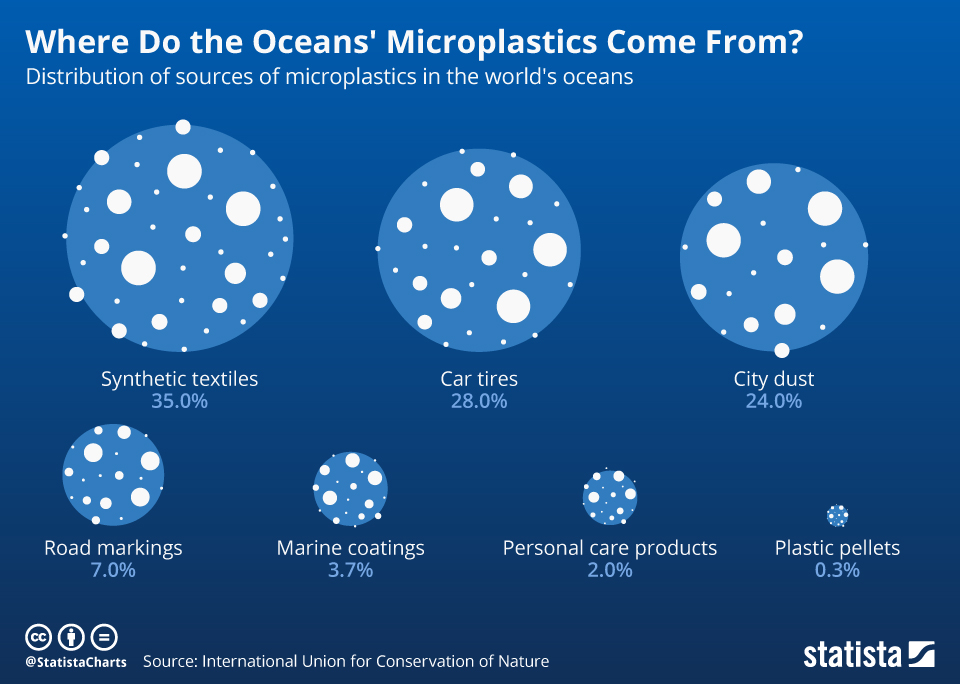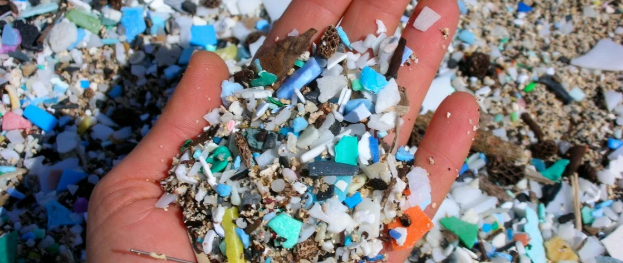Written by: Natalia Brown
Microplastics, as indicated by their name, are tiny bits of plastic that measure less than five millimeters in diameter. That’s about the size of a small green pea! According to The Ocean Cleanup, approximately 1.2 million tons of microplastic waste are generated each year, and 1/5th of that global statistic comes from North America alone.
Primary microplastics are often manufactured for consumer products such as cosmetics, specialty soaps, clothing, and other textiles. Because plastics are prone to physically breakdown, microplastics may also form as larger debris breakdown. The road markings indicating lane separations, glossy coating all over the hull of a boat, and abandoned rubber tires are all possible sources of these secondary microplastics.

Just last month, one study documented the highest concentrations of microplastics ever recorded within deep-sea ocean sediments: 1.9 million microplastic pieces per square meter!
The scientists were examining sediment samples from the depths of the Tyrrhenian Sea to investigate the role of deep ocean currents in microplastic transport and deposition, and all 16 of their sediment core samples were found to contain microplastic particles.
According to the Society of Environmental Toxicology and Chemistry, littering and landfill discharge are the main pathways whereby plastics enter our rivers and oceans. The density of plastic marine debris accumulated determines if plastic waste remains on the surface, becomes beached in coastal areas and estuaries, or sinks to deep-sea sediments.

As we strive to reduce plastic consumption and adopt more responsible waste management practices, it is important to address the potential impacts of microplastic movement in our oceans. Ocean circulation patterns are formed by global trade winds and forces created by the Earth’s rotation. Wind and wave patterns are essential for the temperature regulation and maintenance of healthy nutrient flow for marine organisms.

Weather conditions and ocean circulation play a significant role in the geographic distribution of microplastics. Circular ocean currents can relocate plastic marine debris from remote sources to more stationary and centralized accumulation sites called “gyres.”
Disproportionately large amounts of marine debris have been found in these areas, including the North Atlantic and Great Pacific garbage patches.
Studies have also consistently indicated that microplastics are unintentionally consumed by marine organisms. Scholars highlight the ingestion of microplastics by species marked for human consumption and the infiltration of micro- and (even smaller) nanoplastics in filtered drinking water. This is a widespread problem because most standard water treatment facilities do not effectively remove all microplastics.
Additional risks are posed by the chemical composition of microplastics. While plastics are produced, hundreds of chemical additives are used to enhance their unique characteristics. These chemicals may leach out from waste products into our waterways, disrupting the chemical composition of natural sea water while posing risks to plants and animals reliant on marine ecosystems. Studies on the biological and biochemical impacts of plastic pollution have only scratched the surface of potential effects that these materials could have over the long-term. This knowledge gap is particularly problematic for coastal and/or environmental justice communities that are more likely to be exposed to polluted waterways, contaminated drinking water, or affected marine life.
Even though microplastics have been a problematic by-product of solid waste for decades, they represent a relatively new area of multidisciplinary study. Scientists have investigated the fate of plastic marine debris in the context of the life cycle of plastics, finding that plastic cannot be chemically broken down on its own overtime. Plastic waste, instead, only physically decomposes from macro- to micro- to nano-plastics over hundreds of years.
Polymer scientists have sought to identify new possibilities for recycling plastics, including macroplastics, collected from the depths of our oceans. This has been a challenge because there are a number of unique plastic polymers used to produce the highly durable products that we use and discard. Two large areas of focus have been optimizing methodology to increase the amount of times that plastic materials can be recycled and finding new ways to transition existing materials for very different applications than their original form. One example of an area for growth is demand for composite materials made from fiberglass and carbon fibers. Engineers use these materials for building automobile and wind turbine frames. It would be ideal to satisfy their needs using reprocessed plastics, but that would require complex logistics and technology that is not yet efficiently coordinated.

“Plastics recycling with a difference” [Science Magazine]
For now, it’s best for us to stay committed to recycling efforts, strive for circularity by reusing and re-purposing materials we already own, advocate for responsible waste management within our communities, and direct advocacy efforts to hold businesses accountable for their actions. We can also seek out products that do not contain primary plastics, such as natural soaps and scrubs without microbeads, and brands that prioritize circularity by including recycled materials in their supply chain. If you crave that scrubby sensation from skincare products, try making your own with coconut oil and sugar or salt as the base ingredients. There are loads of ingenious fragrance combinations out there using essential oils that may be extracted from herbs or fruits you already have at home. In the end, it’ll have the same satisfying and nourishing effect, without negative environmental impacts!



